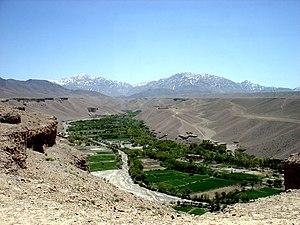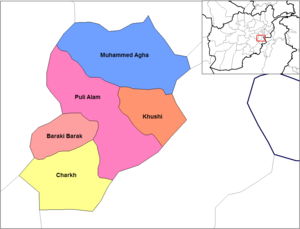Logar Province: Difference between revisions
No edit summary |
No edit summary |
||
| (One intermediate revision by the same user not shown) | |||
| Line 1: | Line 1: | ||
{{Expand|date=January 2007}} |
|||
{{Infobox Administrative Division 1 |
{{Infobox Administrative Division 1 |
||
|country = Afghanistan |
|country = Afghanistan |
||
| Line 10: | Line 11: | ||
|area = 3,880 |
|area = 3,880 |
||
|density = 75 |
|density = 75 |
||
|languages=[[Pashto]]<br/> [[Dari ( |
|languages=[[Pashto]]<br/> [[Dari (Persian)|Persian (Dari)]] |
||
}} |
}} |
||
Revision as of 22:01, 7 December 2007
Template:Infobox Administrative Division 1
Lowgar (Pashto: لوګر; frequently "Logar") is one of the 34 provinces of Afghanistan. It is located in the central zone, southeast of Kabul, and the geography of the province centers on the large Logar River which enters the province through the west and leaves to the north. Its capital is Pul-i-Alam. Logar has a Pashtun majority.
Name
Some say that lowgar is actually "Loy-Ghar" which means "big mountain" in Pashto. References to this can be found in old history books such as the Tarikh e Pehsawar and the Gazeteer of Kohat, 19th century.
History and legend
It has been widely held by Pashtun Khattak tribes as well as historians of Pashtuns and Afghania that Logar is the birth place of the Khattak, Afridi, and Orakzai tribesmen. It is believed that the first record about these tribes going back to the 12th and 13th centuries relates to Logar. Further, is has been in record that the Khattak, Afridi, and Orakzai tribes have descended from the same parent tribe. As a proof it can be seen that Logar is close to the Pakistani area of Bannu on the opposite side of the Durand line, and Bannu is known to be the first area settled by the Khattaks.
Politics
Logar is a generally religiously conservative province, although not to the extent of its southern neighbours. The province's political history is a microcosm of Afghanistan's recent turbulent past, with portions of the province controlled by both the Taliban and the Northern Alliance previous to the American invasion of 2001. During Jihad time Baraki Barak, Khushi, Charkh and Pule Alam districts were controlled by Jamiat e Islami. The province also was home to several Al-Qaeda training bases during that time, although the residents of the province were reportedly unfriendly to the foreign fighters. Mohamad Agha district has long been a stronghold of the Hezb-i-Islami political party, which won seats in the 2005 parliamentary election[1], although the parliamentarians are not officially affiliated with the fugitive leader of Hezb-i-Islami, Gulbuddin Hekmatyar. Additionally, the Northern Alliance-affiliated Jamiat-i-Islami was in control of the province for several years after the fall of the Taliban government.
The Governor of the province is Abdul Karim Hashimi.
Geography

Logar can be generally described as a relatively flat river valley in the north and central regions, surrounded by rugged mountains to the east, south, and southwest. The district of Azra, in the east, consists almost entirely of mountains, while travel to the Paktia province to the south is limited to the Tera Pass, a 2896m high road that was recently completed as part of the international reconstruction effort in Afghanistan.
Although the government of Afghanistan recognizes the Azra district as being in Logar, many widely-accepted maps include it in the Paktia province to the south.
Security situation
While more stable than some of its neighbouring provinces in the country, Logar sees a constant high level of anti-government activity, primarily in the form of car bombs and rocket attacks on government, military and civil targets. Unlike portions of southwest Afghanistan, poppy production is nearly non-existent, due to terrain and weather conditions. Tribal land disputes are a source of unrest, as is the case across much of the country.[2]
Capital

Logar's capital is the city of Pul-i-Alam, located in the district of the same name. It sits on the main road running from Kabul south to Gardez and Khowst province, which borders Pakistan.
Pul-i-Alam has seen a significant amount of reconstruction since the fall of the Taliban. The main road to Kabul was completed in 2006, significantly reducing travel time to the national capital. Additional projects include numerous schools, radio stations, government facilities, and a major Afghan National Police base situated just south of the city.
Like most Afghan cities, there is little municipal planning or services. Electricity is provided by diesel generators, and wells are the primary source of drinking water.
Districts

- Baraki Barak District
- Charkh District
- Khoshi District
- Mohammad Agha District
- Kharwar District
- Azra District
- and central Pul-i-Alam
